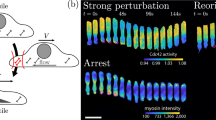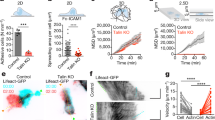Abstract
The development of motility in cultured cells is usually associated with a polarization of the cell shape. In particular, the leading edge of the cell is extended into a lamella which acts as a locus for the elaboration of cell processes and for the formation of cell-substrate contacts and, at the opposite end, retraction fibres often extend beyond the trailing edge of the cell1–3. The alignment of microfilament bundles (stress fibres) along the direction of migration and the presence of a band of actin at the leading edge of the cell suggest an involvement of this protein in the motile process4–8. The direction of growth and orientation of various cell types in tissue culture can be influenced by externally applied d.c. electric fields9 but the effect of the field on cellular motile activities is unknown. Here we describe a galvanotropic response of cultured Xenopus epithelial cells. At a field strength of 5 V cm−1 these cells elongate perpendicularly with respect to the field. The anodal side of the cell retracts and both the ends and cathodal edge become active in the extension of ruffling lamellipodia. In parallel with the change in the cell axis, stress fibres are oriented perpendicularly to the field, and a band of actin is associated with the lamellae at the cathodal edge and at the ends of the cell.
This is a preview of subscription content, access via your institution
Access options
Subscribe to this journal
Receive 51 print issues and online access
$199.00 per year
only $3.90 per issue
Buy this article
- Purchase on Springer Link
- Instant access to full article PDF
Prices may be subject to local taxes which are calculated during checkout
Similar content being viewed by others
References
Abercrombie, M., Heaysman, J. M. & Pegrum, S. M. Expl Cell Res. 59, 393–398 (1970).
Izzard, C. S. & Lochner, L. R. J. Cell Sci. 42, 81–116 (1980).
Buckley, I. K. & Porter, K. R. Protoplasma 64, 349–380 (1967).
Buckley, I. K. Tissue Cell 6, 1–20 (1974).
Small, J. V., Isenberg, G. & Celis, J. E. Nature 272, 638–639 (1978).
Small, J. V. & Langanger, G. J. Cell Biol. 91, 695–705 (1981).
Herman, I. M., Crisona, N. J. & Pollard, T. D. J. Cell Biol. 90, 84–91 (1981).
Heath, J. P. & Dunn, G. A. J. Cell Sci. 29, 197–212 (1978).
Jaffe, L. F. & Nuccitelli, R. A. Rev. Biophys. Bioengng 6, 445–476 (1977).
Jones, K. W. & Elsdale, T. R. J. Embryol. exp. Morph. 11, 135–154 (1963).
Peng, H. B. & Nakajima, Y. Proc. natn. Acad. Sci. U.S.A. 75, 500–504 (1978).
Burridge, K. Nature 294, 691–692 (1981).
Abercrombie, M., Heaysman, J. E. M. & Pegrum, S. M. Expl Cell Res. 67, 359–367 (1971).
Marsh, G. & Beams, H. W. J. Cell. comp. Physiol. 27, 139–157 (1946).
Jaffe, L. F. & Poo, M.-M. J. exp. Zool. 209, 115–128 (1979).
Patel, N. & Poo, M.-M. J. Neurosci. 2, 483–496 (1982).
Hinkle, L., McCaig, C. D. & Robinson, K. R. J. Physiol., Lond. 314, 121–135 (1981).
Letourneou, P. C. in Neuronal Development (ed. Spitzer, N. C.) 213–254 (Plenum, New York, 1982).
Peng, H. B., Cheng, P.-C. & Wolosowick, J. J. Devl Biol. 88, 121–136 (1981).
Lazarides, E. Nature 283, 249–256 (1980).
Poo, M.-M. & Robinson, K. R. Nature 265, 602–605 (1977).
Orida, N. & Poo, M.-M. Nature 275, 31–35 (1978).
Edelman, G. M. Science 192, 218–226 (1976).
Cooper, M. S. & Keller, R. E. J. Cell Biol. 95, 323a (1982).
Erickson, C. A. & Nuccitelli, R. J. Cell Biol. 95, 314a (1982).
Stump, R. F. & Robinson, K. R. J. Cell Biol. 95, 331a (1982).
Nieukoop, P. D. & Faber, J. Normal Tables of Xenopus laevis (Daudin) (North Holland, Amsterdam, 1967).
Lin, J. J. C. Proc. natn. Acad. Sci. U.S.A. 78, 2335–2339 (1981).
Author information
Authors and Affiliations
Rights and permissions
About this article
Cite this article
Luther, P., Peng, H. & Lin, JC. Changes in cell shape and actin distribution induced by constant electric fields. Nature 303, 61–64 (1983). https://doi.org/10.1038/303061a0
Received:
Accepted:
Issue Date:
DOI: https://doi.org/10.1038/303061a0
This article is cited by
-
Computing on actin bundles network
Scientific Reports (2019)
-
Electric fields affect the orientation of cortical microtubules and cell expansion in pea callus
Protoplasma (1995)
-
Biphasic response of human polymorphonuclear leucocytes and keratinocytes (epitheliocytes) fromXenopus laevis to mechanical stimulation
Protoplasma (1992)
-
Longitudinal growth of skeletal myotubes in vitro in a new horizontal mechanical cell stimulator
In Vitro Cellular & Developmental Biology (1989)
-
Effects of cyclic mechanical stimulation of the cellular components of the heart: In vitro
In Vitro Cellular & Developmental Biology (1988)
Comments
By submitting a comment you agree to abide by our Terms and Community Guidelines. If you find something abusive or that does not comply with our terms or guidelines please flag it as inappropriate.



